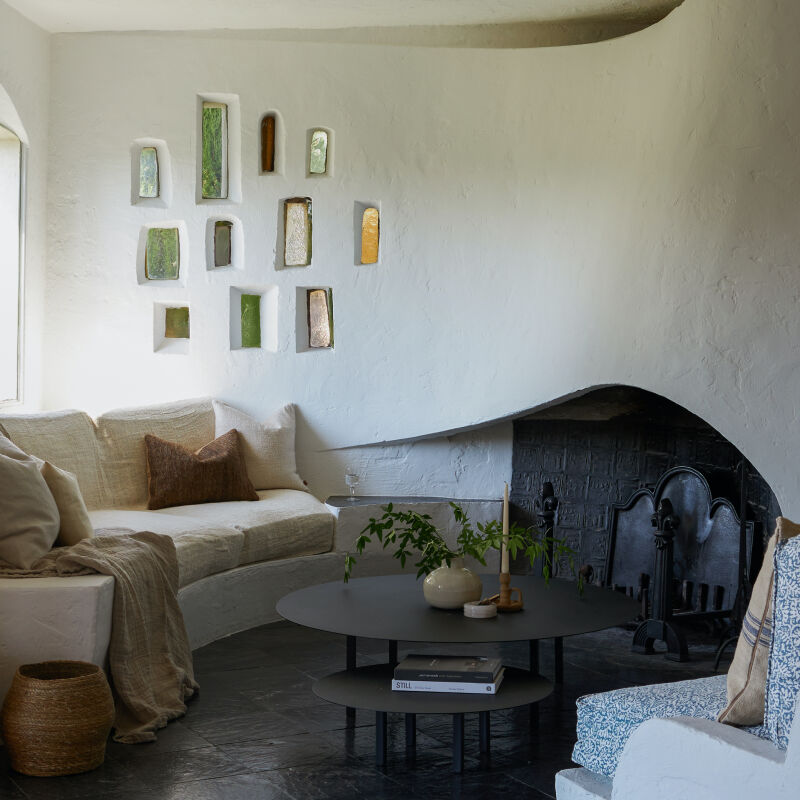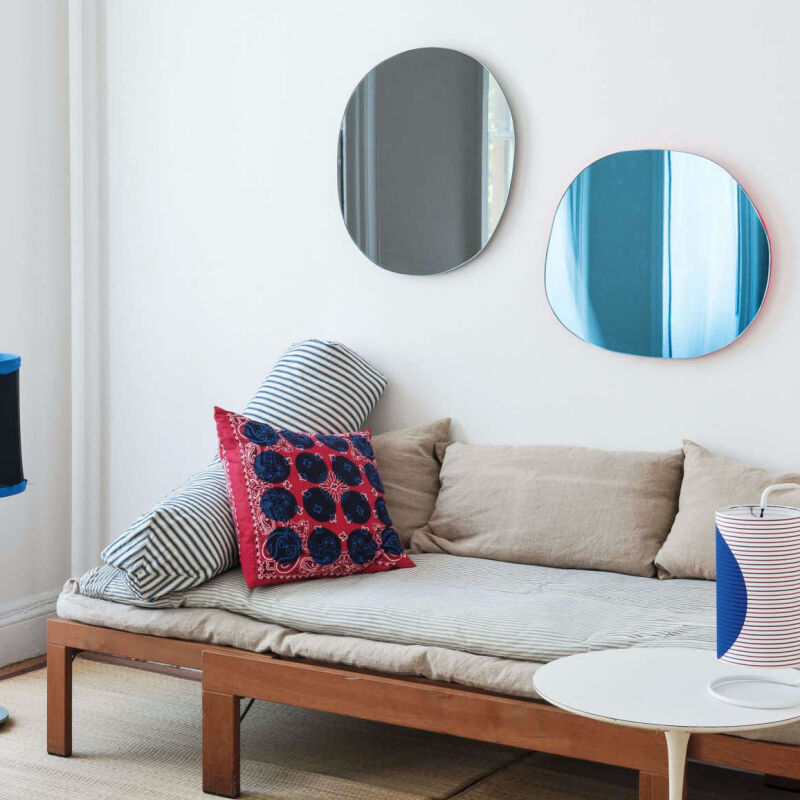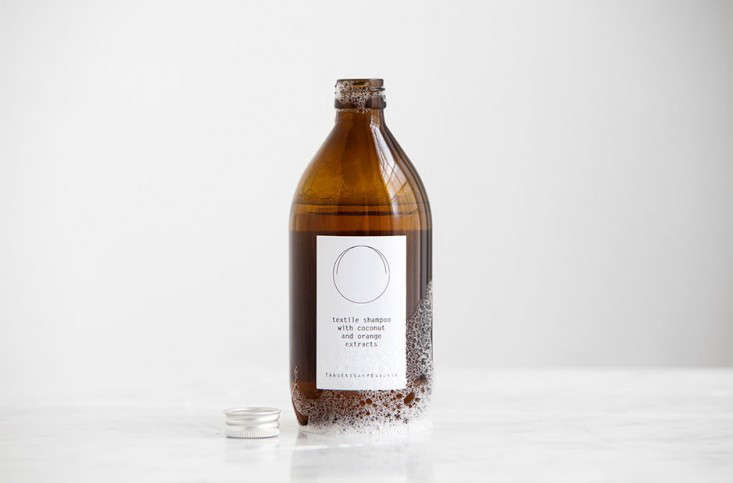It was only fitting that, on my way to meet London-based architect Spencer Fung, I walked from the stately brownstones of Brooklyn Heights onto a wooden footbridge that wove through the tree canopy, then lower, sloping down onto the banks of New York’s East River, with a dirt path and garden beds of grasses. A few days ago I met Fung—the architect behind the UK-based Daylesford organic farm shops and spas and the author of Architecture By Hand—at the 1 Hotel Brooklyn Bridge, where he’s designed the latest Bamford Haybarn spa. Inside, the space feels miles from the city, a theme in Fung’s work: Having grown up in Hong Kong (what he calls “concrete boxes”), he now takes inspiration from nature—stone walls, stacked wood, hay bales—and from natural materials like stone, wood, steel, and concrete. He selects branches by hand and incorporates them into his designs, re-kindles ancient tools and techniques, and embraces the art of collecting. Fung is also an artist, painting watercolors in situ with pigments made from “water from the lake and river, soil, and moss. Always my hands are quite dirty,” he says, taking walks for inspiration, through Hampstead Heath in London or the Pyrenees in the summer, thoughtfully using nature as his guide in art and architecture.
Over a cup of coffee in the hotel’s lobby with Fung and his wife, Teresa Roviras, I asked him for his thoughts on what he calls “slow architecture,” and how he incorporates organic modernism, nature, and tactility into design. Here’s a glimpse of our conversation:
Photography courtesy of Spencer Fung.

On finding inspiration from nature in the city:
Growing up in Hong Kong, Fung says, “My second home was an apartment block by the water’s edge,” the view of which was soon eclipsed by “more apartment blocks.” But he remembers a small park nearby, “hopping around granite boulders, dragonflies among the creek”—taking delight in what nature he could find. It set the course, he says, for the work he’s doing now.
On the fundamentals of nature:
Roviras (a designer in her own right; she owns children’s line Hedgehog) tells me that Fung’s first questions when beginning any project are: “Where can I bring in natural light? Where can I bring in fresh air?” Begin with the basics.

On showing the process:
“My work is all about work in process,” Fung says. “Stop: Don’t cover it up. It’s so beautiful, with shadow and light.” In his own home, he ensured that the plater showed the “hand trail” of the plasterer; in the new spa, concrete floors have imperfect swoop-like patterns that almost look like the shadows of leaves. The marks are created when the craftsmen are polishing the floors and resin is released, but rather than continue, Fung asked them to stop, to show the motions of the work on the floor. (To incorporate this idea at home without a full remodel, Fung suggests commissioning a local artisan or craftsman to make a rug or lamp shades. “You own this and you can carry this with you,” he says.)
On ancient techniques:
Many of the wooden surfaces of the spa, and throughout Fung’s work, are hewed in a pattern like the underside of scales. He’s discovered that it’s a technique used in Latin American and Native American traditions, and that the tools are also the same: “an ancient skill still relevant today,” he says. There are lessons to be learned from how things have been done for centuries.

On tactility
In his work, Fung considers not just how a room or a space will look, but texture, and how it will feel to the people in it. “A lot of work, people like to touch,” he says. Similarly, Roviras says, Fung will start a drawing with a tiny detail—someone’s foot, for example—and then draw outwards, sketching in a whole room around it. When designing a room, consider first small details like texture and tactility.

On reuse
One wood Fung has fallen in love with is holly. When he discovered that there was an estate near Hampstead Heath with lots of holly that needed to be cleaned out every year, he arranged a situation where he could collect the felled wood. “It’s giving new life to something forgotten,” he says.
On walks in nature
When at home in London, Fung walks in Hampstead Heath (“our backyard,” say Roviras). In summer the couple and their children hike in the Pyrenees; this year Fung was particularly moved by a mountaintop lake and painted it. That collection, called Lake of Hope, is soon to be on exhibit in London.

On collecting unexpected finds
Collect thoughtfully, everywhere. The couple gathers found items from nature: rocks and sand; soil and crushed leaves for Fung’s on-the-spot watercolors; an unusual piece of driftwood that, when hung on the wall, looks like a bleached animal skull. In their studio is a collector’s drawer full of iron segments: some collected from the Pyrenees, others iron anklets from Africa and the Costa Brava. While they’ve been in New York this week, the couple says, they’ve been collecting seeds from their walks in the city.
On embracing weather and time as a design element
Fung has a love of “white wood, weathered by time and nature,” he says. While we’re in the spa, he points to a column of cedar wood which, after lying unused in the craftsperson’s backyard for ten to fifteen years, took on a weathered grey color. “This grey, you can’t recreate it,” Fung says, explaining that he chose it because “it feels like the piers” on the nearby East River.

On his favorite wood, for furniture or craft
“Ash is the gentleman of a tree, more understated, elegant, more upright,” Fung says. It allows sunlight through to nurture the plants below: “a caring tree,” he says. As we walk by a tall, sculptural branch marking the entrance to the spa, Fung points out narrow channels carved into the wood, the trail of an ash borer, the insect that is plaguing American ash. (In the UK, he tells me, it’s a fungus that is threatening the tree.) Fung traveled to Colorado to hand-select the wood for the spa: a lesson in sourcing locally and working to protect endangered nature, but also in embracing imperfection.
On sourcing materials that last
Fung believes in using what he calls “noble materials.” Things like a beautiful piece of marble, he explains, might find a second or third life, even if the upfront cost is more expensive, while something like tile might be discarded, rather than reused. “It’s a reaction against throwaway culture,” he says.

On his favorite organic modernism essentials
White paint: Shirting by Little Green, he says—he’s used it on the ceilings of the spa to create a neutral backdrop for wood and natural textures.
Fabric: “I like to use natural linen because of the natural feel and the incomparable silky sheen,” Fung says. “I like to use all different colors and shades of linen fabric.”
Rugs: Fung loves esparto natural grass fiber rugs; he and Roviras recently bought some from local shops near Barcelona. “They are handmade in strips and sewn together. Picasso used them on his studio and home floors too,” he says.
From Ikea: “We use their natural linen curtains for our home, and some wicker woven pendant lamps in our dining room.”
On a small step towards bringing nature indoors
“Go to a local park, take a handful of fall leaves,” Fung says. “Already that’s a palette, isn’t it?”

On imperfection
“Imperfection is beautiful,” Fung says. His work, he says, is “all about celebrating that.”
N.B. To see more of Fung and Roviras’ London home, see Slow Architecture: An Elegant, Monochrome Home in London by Spencer Fung.
More Expert Advice:
- Expert Advice: Developing Style with Designer Cassandra Ellis
- Expert Advice: 7 Tips for Sourcing from Salvage with Architectural Designer Tom Givone
- Expert Advice: Architects’ Top Tricks for Creating a European-Inspired Interior
Frequently asked questions
Who is Spencer Fung?
Spencer Fung is a Canadian designer who specializes in organic modernism - a design philosophy that emphasizes the beauty of natural materials and the interconnectedness of nature and design.
What is organic modernism?
Organic modernism is a design philosophy that blends modern aesthetics with natural materials. It emphasizes the importance of the relationship between nature and design, and celebrates the beauty of natural forms and textures.
What are the key principles of organic modernism?
The key principles of organic modernism include: using natural materials, celebrating natural forms and textures, emphasizing the relationship between nature and design, and prioritizing simplicity and functionality in design.
How do I incorporate organic modernism into my home?
To incorporate organic modernism into your home, you can start by focusing on natural materials like wood, stone, and leather. Add in natural textures like wool or cotton, and incorporate natural elements like plants and greenery. Keep your design simple and functional, with clean lines and minimal embellishments.
What sets organic modernism apart from other design styles?
Organic modernism is unique in its focus on natural materials and the relationship between nature and design. It celebrates the beauty of imperfection and the natural world, and prioritizes simplicity and functionality in design over ornate flourishes or excess.
What should I keep in mind when designing a space with organic modernism?
When designing a space with organic modernism, keep in mind the importance of natural materials and textures. Choose a neutral color palette and prioritize simple, functional design over ornate flourishes. Incorporate natural elements like plants and greenery, and focus on the beauty of imperfection in natural forms.







Have a Question or Comment About This Post?
Join the conversation